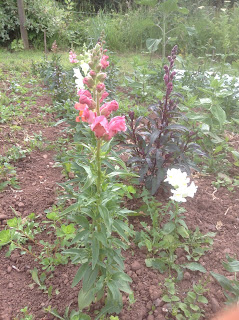News from The Orchard
It's been a hard and cold week. S and R are going away for 10 days and are hoping for a turn around in the weather and the growth whilst they are away hunting down vintage costumes in France...
Rabbit attack on all the beans. This has never happened before and it's difficult to think of humane or reasonable strategies to make them go away. R and S are trying 'liquid fence ' which is organic and safe for people pets and plants but is meant to repel by its scent. We suspect it doesn't work...
Weeds are sadly overtaking the flowers. The worst one looks like a low slung thistle. S suspects the weeds are worse this year because of rotavating so it's going to be black plastic or back to digging over next winter.
The Sweet Williams are ready for picking - still beautiful big pink and red heads.
Aphids are still plaguing the apple tree and being harvested by ants - soapy water seems to be relatively unsuccesful but the apples themselves look ok and it's just deforming the leaves.
All the sweet peas have been munched in the orchard by slugs but they are ok at home as the plants are stronger and the organic pellets seem to help.
And news from the Combe cottages flower gardens...
Despite the cold week we've had some successes and the garden looks pretty good.
Highlights are:
The amazing dahlias are now sticking up their little leaves
(and only a few have been munged so far)
Slug patrolling is doing well - 50 found and squashed last night. (For this technique you need one very bright torch, a pair of gloves, heavy shoes/wellies and a strong stomach! You need to go out between 11 and midnight, use the torch to spot them, pick them up and squash! Disrupting the soil around where the slug has been I think also makes sure no one uses the trail again ....)
The front of the house is a treat!
Sweet peas are looking possibly the best ever. We sewed them in February in loo rolls - a mixture of saved seeds,
Lovely white and black dot flowers on the broad beans
The golden Rose on the front of the house has been in full flower all week.
And lovely pinks in pots
The failures and sadnesses this week
Burning the fireblight tree - although 2 small boys did have beans and sausages on the campfire building up to it. Other apple tree beginning to fruit and looks very healthy.... Let's hope the blight has not spread.
So much black fly on the broad beans ... I'm trying just spraying them off with the hose after pinching out the tops.
Interesting fact of the week
The term "fire blight" describes the appearance of the disease, which can make affected areas appear blackened, shrunken and cracked, as though scorched by fire.






































